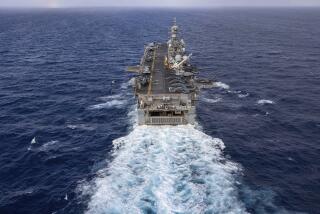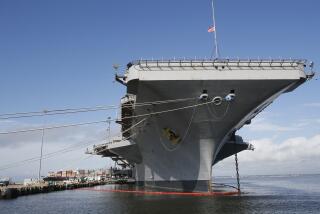Changes in Operating Procedures Could Be in Store : Navy Applying the Lessons of ‘Do-It-Yourself War’ in Gulf
- Share via
MANAMA, Bahrain — Emerging from what a senior commander calls a “do-it-yourself war” in the Persian Gulf, the U.S. Navy is absorbing and, in some cases, already applying lessons learned in a year of unrelenting tension and sudden bursts of combat.
Although not a direct participant in the war between Iraq and Iran, the United States sent warships to ensure freedom of shipping in the gulf. The Navy found itself committed to its biggest, costliest mission since Vietnam and by some measures since World War II.
Between July 24, 1987--when the Kuwaiti supertanker Bridgeton struck a mine while under U.S. escort--and the Iraq-Iran cease-fire on Aug. 20, 1988, Navy ships and aircraft engaged in more than a dozen armed clashes with Iranian forces and encounters with Iraqi warplanes.
Could Lead to Changes
Officers say the gulf experience, which included the first combat use of many computer and weapons systems, could lead to many changes in operating procedures, shipboard equipment and even a revived emphasis on survivability in warship design.
It also is prompting a serious look at more subtle questions such as stress. Sailors in the gulf were living under a constant state of high alert and performing the technical tasks of missile warfare. Officers often had only seconds to make major decisions.
Official concern about stress was given special impetus by the July 3 disaster in which the missile cruiser Vincennes mistook an Iranian jetliner for a military attack plane and shot it down, killing all 290 aboard.
U.S. investigators said the pressure of first-time combat caused Vincennes radar operators to misinterpret crucial computer data, and recommended that stress and the “human factor” be studied for future training purposes.
Aegis System Modified
Although investigators said the ship’s Aegis radar-weapons system worked as intended, the system is being modified to yield more precise information on aircraft threats.
The Navy also has made or is planning changes in shipboard emergency procedures, damage control and firefighting methods as a result of the near-sinking of the missile frigates Stark and Samuel B. Roberts.
Thirty-seven crewmen were killed on the Stark when it was hit by two Iraqi missiles on May 17, 1987, and 10 of the Roberts’ crewmen were hurt when it was almost ripped in half by an Iranian mine last April 14.
The gulf inspired the Navy’s first use of computer systems to train officers and crews for a specific combat zone. The computers simulated gulf geography and tactical situations, with tapes of actual radio traffic for added realism.
Quadrupled Gulf Force
The United States had kept a small flotilla in the gulf since 1949, but it quadrupled after President Reagan agreed in mid-1987 to reflag and escort Kuwaiti oil tankers menaced by Iran, which considered Kuwait an Iraq ally.
The buildup ultimately reached more than 30 warships in the region, spurring similar moves by five West European governments.
Gen. George B. Crist, head of U.S. Central Command and architect of the operation, said the 600-mile-long gulf, crowded with ships, oil rigs and besieged by warring neighbors, was a “learning experience” for the Navy, whose strategies are built on long-range ocean warfare.
“It was a real do-it-yourself, come-as-you-are operation,” said Crist, whose Florida-based command controls U.S. military activities in the Middle East. “There were no books, no doctrine.”
Rusty in Running Convoys
The Navy, for example, had not run an ocean convoy since World War II, and the only officers trained for the task were civilian reservists.
Teachers, accountants and merchant mariners were recalled to active duty as liaison officers aboard the Kuwaiti tankers.
Improvising for “guerrilla warfare at sea,” Crist hired tugboats as temporary minesweepers and leased two huge barges as floating combat bases after Arab states rejected U.S. pleas to use their territory.
He said the barges, an idea borrowed from Vietnam where American forces patrolled from bases in enemy-held areas, showed it was possible to range far afield “without a tremendous base infrastructure . . . and still project our power.”
‘Mobile Sea Bases’
U.S. officers say the “mobile sea bases” were instrumental in discouraging Iranian shipping raids in the northern gulf for seven months before the cease-fire. Their secret, night-flying Army helicopters also caught an Iranian minelayer, proving that Tehran was mining gulf sea lanes.
Navy ships, built to fight submarines and aircraft, were ill-equipped to combat Iran’s armed speedboats and Chinese-made Silkworm missiles, considered the main threats to U.S. convoys.
Gulf-bound warships soon were being fitted with new firepower--machine guns, a laser-sighted Army tank cannon, and the radar-guided Phalanx Gatling gun that hurls a storm of shells at incoming missiles.
Even before the July 3 Airbus tragedy, some U.S. officers had criticized the choice of the billion-dollar Vincennes as being too much ship for the gulf. Aides say, however, that Crist stands by the decision, which was aimed at countering an Iranian missile threat.
Some Ideas Fizzled
Some other ideas fizzled or never got started.
Navy helicopter minesweepers toiled six months in the gulf’s grueling heat and dust without finding a mine. Vietnam-era river patrol boats proved useless. Officials twice considered and abandoned the idea of calling in the U.S. Coast Guard.
Five dolphins trained in a top-secret Navy project to guard against underwater sabotage were sent to the gulf, but returned home after one died from a virus.
Crist said one of his biggest problems was a command structure in which the Navy’s gulf commander answered to him, while some carrier groups in the Arabian Sea remained under Pacific fleet jurisdiction.
To solve the command split, Crist created a unified Joint Task Force Middle East, directly under his headquarters.
More to Read
Sign up for Essential California
The most important California stories and recommendations in your inbox every morning.
You may occasionally receive promotional content from the Los Angeles Times.













